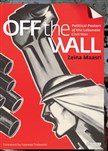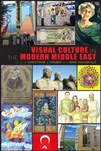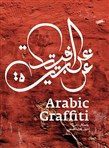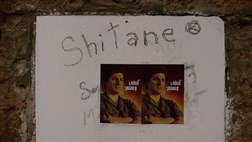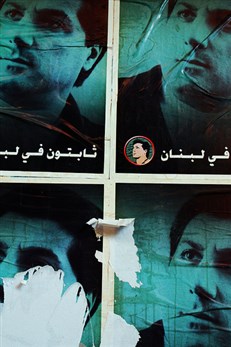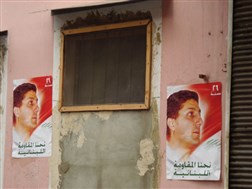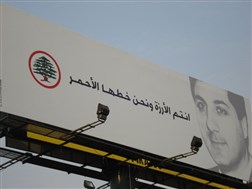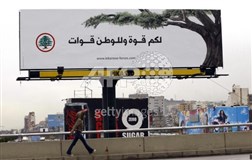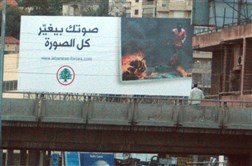The return of the Lebanese Forces (LF) to national politics in 2005 was approached on the basis of reconciliation. This approach was arguably different from that of its original debut in 1976, or throughout its existence prior to being banned in 1994. After his liberation from prison, Samir Geagea, leader of the party, promised a new path in his discourses. In one of his speeches held in commemoration of the LF martyrs, he even went so far as to publically confess to his questionable past and that of his party, asking the citizens of Lebanon for forgiveness. This shift in political discourse took place within a different Lebanese context; one that emerged as a result of the withdrawal of Syrian troops from an independent Lebanon. Despite this change in national context, I argue that the behavior of the Lebanese Forces remains closer to that of a para-military faction than of a political party. In this sense, it also distinguishes itself from its coalition with March 14th, as could be seen in its pre-election campaign: "For you the force and for the country the Forces", that will be analyzed below.
Nader Moumne argues in his thesis "The emergence and transformation of the Lebanese Forces in wartime Lebanon, 1975-1988"[1] that the distinction between party and faction is very ambiguous in Lebanon" because of the strong communal loyalties that the Lebanese people have. One of the first articles that one could read on the main page of the Lebanese Forces official website, is entitled: "Father Moubarak for 'Al-Dyar': the federation is the solution".[2] This refers to the [historically rumored] LF desire to create a national system of federal states based on religious confession. Using ascription to communal loyalties as the basis, I am going to analyze the depiction of the "us versus them" relation in the posters of the Lebanese Forces from 2005 up until the elections in 2009. I argue that the method adopted by the Lebanese Forces during this time period can be compared with those used during the Lebanese civil war, despite belonging to different contexts and situations. These depictions intensify the demarcation to an extent where the other is portrayed as a violent aggressor, barbaric adversary, and faceless enemy, especially in their last campaign (fig. 9). Such identification of local components intensifies the "estrangement of the other"[3], and deepens existing internal divisions. The other is portrayed as an enemy, reminding the public of previous confrontations, and fixing it in a frame of mind that goes back to the wartime period.
The emergence and formation of the Lebanese Forces
The Lebanese Forces was formed after the Tal al-Za'atar confrontation between the Palestinian resistance and diverse Christian militias. Tel al-Za'atar fell in the hands of the Christian militias on August 12th, 1976. On August 25th, 1976, Christian militias leaders where invited by Bashir Gemayel, commander of the Kataeb Security Council, and formulated a unified command structure that they named "Lebanese Forces". The LF evolved in several phases from the time it was created 1976 till the time it was banned 1994. It witnessed "the unification of the Christian gun" on July 7th, 1980, the ascendancy of Bashir Gemayel to the presidency, 1982, and his assassination. Then the occurrence of power struggle within the LF happened between president Amin Gemayel, Hobeika and Geagea. Finally, Geagea took over after the January 15th 1986 rebellion against Hobeika, and institutionalized the Lebanese Forces. In 1994 Geagea was accused of bombing a church in Zouk, and the LF was banned.
From the time of its creation in 1976 till Samir Geagea was arrested in 1994, the aim of the Lebanese Forces was to secure the Christian region and protect the sovereignty of Lebanon by defending the existence of the Christian community from what it considered its enemy "other" (Palestinian resistance, and later the Syrian army and their Lebanese allies). As Naoum Farah, spokesman of the Lebanese Forces, declared on July 8th, 1980, "the Christian resistance will have a unified regular army of its own to preserve the basic rights of the Christian people."
On July 26th, 2005, after 11 years of imprisonment, Samir Geagea, leader of the LF, was liberated and the LF immediately reappeared on the Lebanese political scene. It introduced itself as part of the larger March 14th coalition, formed by various political parties representing diverse religious confessions, knowing that the Lebanese public perceived LF as an isolated group. The unified coalition had one similar goal for Lebanon, to get rid of the Syrian military and political presence and its interference in the country's affairs.
This shared nationalist discourse among the March 14th coalition and aimed mainly against an external enemy, shifted to internal divisions during the 2006 July war, where a clear demarcation was articulated between the two opposing alliances, March 14th and March 8th. The opposing "other", March 8th, led by Hezbollah, was blamed for the massive destruction that occurred during the war and the instability that the country witnessed. The Lebanese Forces took a clear stand in opposing the internal counterparts that it held responsible. Along with the March 14th coalition, it launched the "culture of life" campaign. This marked the beginning of an offensive within the political discourse, aimed not only against Hezbollah, but also its allies in the broader March 8th coalition. This was present in their discourses in the post-July War period up through the election period in 2009. These discourses can be examined by presenting analyses of official and unofficial campaigns during the election time period.
The 'we' and 'they'
The LF presence and role in relation to their imagined Christian collectivity is reaffirmed and consolidated by the intense opposition to the vision held by the other local parties and their discourse. Chantal Mouffe[4] argues that it is only by the demarcation of a "they" that the creation of a "we" exists. The "us"/ "them" relation is present among most competing political parties and communities in Lebanon, but is heavily articulated in the Lebanese Forces speeches and visual communication, to the extent where the "they" is represented as an enemy threatening the existence of the 'us'.
The Lebanese Forces' visual communication from 2005 till the 2009 elections could be divided into two major phases.
The first phase began with the liberation of Samir Geagea and the party's reappearance in politics in 2005. It continued through the 2006 July war with Israel and the period that followed the end of the conflict. It is during this time that the LF began to reconstruct particular connotations of a collective memory in a shifting context. This phase witnessed the emergence and usage of symbolic and historical visual elements and slogans that went back to the civil war, when the LF were an active militia.
The second phase revolves around the election period, during which the country witnessed an intense media battle between the different political parties. Some campaigns address the "us" aspect, pointing at the party's program, political line, and future goals. Others critique the other, "them", juxtaposing the party campaign against the opponent's preexisting one. The aim of all of these campaigns is to consolidate the party's political vision and to fortify its presence, especially in geographic areas with high concentrations of its supporters. The Lebanese Forces political campaign stands apart from the rest of the parties.
Fisrt Phase
Freedom and Liberation
In relation to Samir Geagea's liberation from prison after 11 years, the leader of the LF was represented standing behind prison bars. Two of which are tilted in way that allow part of his upper body and one of his hand to come out, holding a torch. The same torch was used in previous poster by the Lebanese Forces dating back to 1978-80, where combatant of the Christian resistance are depicted carrying a flame symbolizing belief in Lebanon (ref. fig in archive). The image is complemented with a statement that portrays the injustice that the leader and his party have witnessed in the past few years, "the sunrise of Freedom". This poster comes to reaffirm the party's resisting past and struggle, and actual, present activeness and belief, after 11 years of political absence. It beholds an emotional memory and conscious revival of their historical symbols at the time when they where active. A shared aspect in the Lebanese forces visual communication of that period (2005-2009) and this first phase in particular, is the usage of codes that belong to a different context and presents a defined connotation to layer a suggested message. In a similar approach and context, a poster was released at the same timeframe, stating, "After 10452 days, Lebanon was freed". Also, bringing a popular and loaded expression '10452 km2' to describe and evoke a different situation. '10452 km2',is the total surface area of Lebanon, it links back to the discourse of sovereignty Bashir Gemayel, founding leader of the Lebanese Forces, promised to the Christian community in the midst of the civil war. The expression is reused to promote the hope that the liberation of the Lebanese Forces leader, Samir Geagea, will bring among the 'Lebanese' community.
Commemorative Posters and Their Reconstructed Meaning
During the period that followed the 2006 July war, a wide range of posters were found hanging in the streets of Christian areas, with a majority portraying an omnipresent Bashir Gemayel. Playing on an emotional aspect, and hitting the Christian communal history, these posters contain a similar logic and tonality. They present a Lebanese/Christian discourse that refers back to the civil wartime period and build on its symbols and slogans. Figure 1 presents the figure of Bashir in his LF army fatigue, standing with crossed arms. His posture and intense, serious facial expression show determination, reinforced by the text, which reads "So we can remain and persist". This same poster could be paralleled with another one, dating from 1983, "... Continuing the procession", where Bashir in his military attire passes on the rifle, with a solid and muscular hand, to another LF soldier who proceeds beyond the poster's frame (Maasri 2009: fig. 3.14). Whereas the older one articulate concretely its goal and the means to achieve it, the more recent one is toned down. The complimentary association between text and image imparts a strong message, a desire to stay and continue. While this entails suppressing the "other", it serves more importantly as a stated aim "(for us) to stay and continue". The implied way to achieve this is by resisting, fighting and sacrificing just as Bashir, the martyred hero, did.
Another poster (fig. 2) entitled "persisting in Lebanon", presents a close-up portrait of Bashir in duotone, with an intense expression in his eyes. This poster has a duality in meaning depending on the audience. On the one hand, the "we" might refer to members of the party that was banned for a long while, perceived as an attempt to terminate its political role and beliefs. In this sense, the LF's presence and existence is menaced or threatened by the "other". At the same time, the "we" could be referring to a segment of the Christian audience that is familiar with this specific discourse, one that goes back to the confrontations with Palestinian and Syrian groups during the civil war period. This interpretation is reinforced by the image of Bashir, the main leader and symbol of the Lebanese Christian resistance. This constant, stressed affirmation of their presence and continuity in Lebanon also evokes the idea of a threatened existence.
In commemoration of the 26th anniversary of the assassination of Bashir Gemayel, a revival of this shared memory was issued, reconstructed using a particular political message. The poster (fig. 3) presents a photographic profile of Bashir Gemayel surrounded by a glowing background. This depiction of Bashir likens him to important divine figures in Christianity, as an important person that shielded and embraced Lebanese Christians. This is stressed by the presence of the Lebanese flag in the background, fused with the hallowed and soft light surrounding his figure, appealing to the collective consciousness of the Christian community. This commemorative poster was mainly displayed in Christian inhabited areas, such as Ashrafieh, Ain El-Rummaneh and other popular regions. It places in doubt the discourse of resistance claimed by Hizbullah and March 8th partisans. "We are the Lebanese resistance," it affirms, shifting this discourse from one perspective to another, and from one context to another. It recalls a historical resistance that goes back 26 years, at the time where a Maronite Christian based resistance fought against Palestinians and other groups that it considered threatening the existence of its imagined collectivity and by extension the Lebanese nation-state. This difference in aim, role, and enemy antagonizes Hezbollah's discourse of resistance and its supporters, to the extent where it attempts to nullify it.
Second Phase
Pre-Election Visual Campaign
On the other hand, two campaigns during the pre-election period were produced on a broader scale and were visible to a wider audience. The first one, launched during the summer of 2008, contains three major elements. The central focus is on the textual statement: "you are the cedar and we are its red line". This campaign featured a series of posters, each with the same statement but with the face of different leaders within the Lebanese Front (members of the Gemayel family, Charles Malik, and Camille Chamoun). This particular one is accompanied by a portrait of Bashir on one side, and the LF logo on the other (fig. 4). Bashir's presence, or any of the other figures, is an emotional reminder that embraces the whole party/movement and repositions the political context 30 years in the past. Furthermore, it is strict stance that repositions the LF in the same ranks of their resisting past. The red line that symbolizing perfection and sacrifice, according to their own definition, depicts the pivotal role of the LF in defending their heritage and the persistence of their imagined Christian collectivity, symbolized by the cedar. The use of well-known party figures sets a particular historical context, calling on specific shared memory to tug at the Christian nerves and to engage their collective consciousness. Their faces are in black and white, with a transparent treatment, present yet in the background. The message is aimed at an imagined entity, the Christian collectivity, embodied by the cedar and protected by the red line (i.e. the Lebanese Forces)
The second campaign was released a few months later, towards the beginning of 2009. The poster (fig. 5) is once again talking to the same audience, the people of Lebanon who espouse an imagined Christian entity. A similar layout is presented; three consecutive elements are brought together to communicate a message on a white background. The cedar is visually present embracing the whole. The written part states: "For you the force" (to persist and exist), "and for the country the forces" (to defend its existence and continuation). There is a clear reference to the important role of the 'you', Christian partisans, in the present political situation that ideally should be translated in the coming elections. The trunk of the cedar is the main focus, strengthening the idea of "us", the Christian collective, being the roots and the essence of this Lebanese heritage.
In both campaigns, the LF discourse revolves around a shared memory among a particular segment of the country, a Christian one. Although being part of a larger coalition, the LF discourse in these two specific official campaigns succeed in drawing a margin that divides between it and its allies, yet that is unconsciously or consciously unnoticed for particular political reasons. Other than reusing the images of dead Lebanese Front leaders that fought against Arab nationalist and left-wing Lebanese political parties in the civil war period, of which some are now allies of the LF, such as the Progressive Socialist Party among other Sunni leaders, the appropriation of the cedar, symbol of the Lebanese nation-state, referring to "our" Lebanon, could be interpreted as the appropriation of the Lebanese cause. Using the cedar as an embodiment of their supporters, the Christian community, leaves no room for other local communities, including their allies. This is visibly formulated in their statements where they implicitly exclude anyone but the Christian public who are members of the Lebanese Forces, distinguishing themselves from the other members of the March 14th coalition. The vision of a sovereign, free country and its protection is restricted to them: "you (LF supporters and Christians belonging to this imagined collectivity) are the cedar and we (in the past the Lebanese front leaders and combatants, and in present day the Lebanese Forces) are its red line". Similarly, "For you the force and for the country the Forces" eliminates the participation of other national and local actors, even those in the March 14 coalition. It says specifically: "For the country the LF" and not "For the country March 14th". This silent separation from its coalition, and reminder of political activeness in a Christian military past, reformulate an isolated expression and its accompanying behaviors.
The Elections Visual Campaign
Tackling the Lebanese Forces visual campaign during the elections allows one to understand their position and perception of other Lebanese parties that constitute an opposing political position, as well as their belief in a different strategic vision for Lebanon. In one campaign entitled "Your voice changes the whole frame", images of violent confrontation are framed within a white space. These images include one of Aoun's supporters (wearing orange) in the street with blazing tires (fig. 6), and another of Hezbollah (wrapping the Shi'i kouffieh around his head and neck) holding arms. Both are set in the streets and depict violence. These visuals are engaged both politically and ideologically, where the "other" is fixed as being a barbaric, violent aggressor that threatens the Christian collective consciousness. The first is burning tires, and the second is wearing an Islamic, Shi'i symbol and holding arms pointed at "us" (the Christian community), therefore menacing "our" existence.
Another campaign entitled " You can do nothing or you could do something", follows a similar approach. Both images depict a youth with their backs to the viewer. In the first image (fig. 7) the girl is looking at a scene of armed struggle that refers to the violent clashes between Hezbollah and the PSP in May 2008. In the second image (fig. 8) the guy is looking at a scene of rubble that might refer to the mass destruction that occurred during the 2006 July War. In both events, Hezbollah and its allies were held responsible. Again the "other" is held responsible for violence and destruction leading to instability and damage.
Both campaigns conjure a particular image of "other" local political groups that includes references to fear and oppression, and stress the need for a reciprocal opposing reaction that would change this reality by voting for the Lebanese Forces.
In continuation of this politically oriented discourse, LF initiated a campaign juxtaposing the Lebanese flag against another one with clear Hezbollah features (fig. 9). The aim of this particular image was to generate animosity towards Hezbollah and make the claim that they want to change everything about Lebanon, to the dramatically satirical extreme of changing the flag. They are portraying a faceless enemy who constitutes a threat to an imagined identity.
In conclusion, the visual communication strategy of the Lebanese Forces, whether official or otherwise, always brings back elements of their ideological history and the forces they resisted at different historical moments. They employ these codes in contemporary campaigns and political situations that re-contextualize the ideology and reinterpret the situation at hand accordingly, in turn reinforcing the collective memory of those concerned. This creates a link between the past memory of their public and the contemporary concerns and agenda of the party itself.
Notes
* This essay was originally written for the Signs of Conflict course at the American University of Beirut in the Spring semester of 2006.
[1] Nader Moumne, "The Emergence and tranformation of the Lebanese forces in Wartime Lebanon" (master's thesis, American University of Beirut, 1996).
[2] http://www.lebanese-forces.org/articles_geagea.shtml
[3] Zeina Maasri, Off the Wall: Political Posters of the Lebanese Civil War (London: I.B.Tauris, 2009).
[4] Chantal Mouffe, On the Political (London: Routledge, 2005).
Bibliography
Anderson, Benedict. Imagined Communities: Reflections on the Origin and Spread of Nationalism. London: Verso, 1991.
Barthes, Roland. Image Music Text. Edited and translated by Stephen Heath. London: Fontana Press, 1977.
El-Khazen, Farid. "Political Parties in Postwar Lebanon: Parties in Search of Partisans." Middle East Journal 58, no.4 (2003): 605-626.
Maasri, Zeina. Off the Wall: Political Posters of the Lebanese Civil War. London: I.B.Tauris, 2009.
Mouffe, Chantal. On the Political. London: Routledge, 2005.
Moumne, Nader. "The Emergence and Transformation of the Lebanese Forces in Wartime Lebanon". Master's thesis, American University of Beirut, 1996.
Said, Edward. "Invention, Memory, and Place." Critical Inquiry 6, no. 2 (2000): 175-192.
Snider, Lewis. "The Lebanese Forces: Their Origins and Role in Lebanon's Politics." Middle East Journal 8, no.1 (1984): 1-33.
http://www.lebanese-forces.org/articles_geagea.shtml
http://www.lebaneseforces.com/lflogo.asp.html
